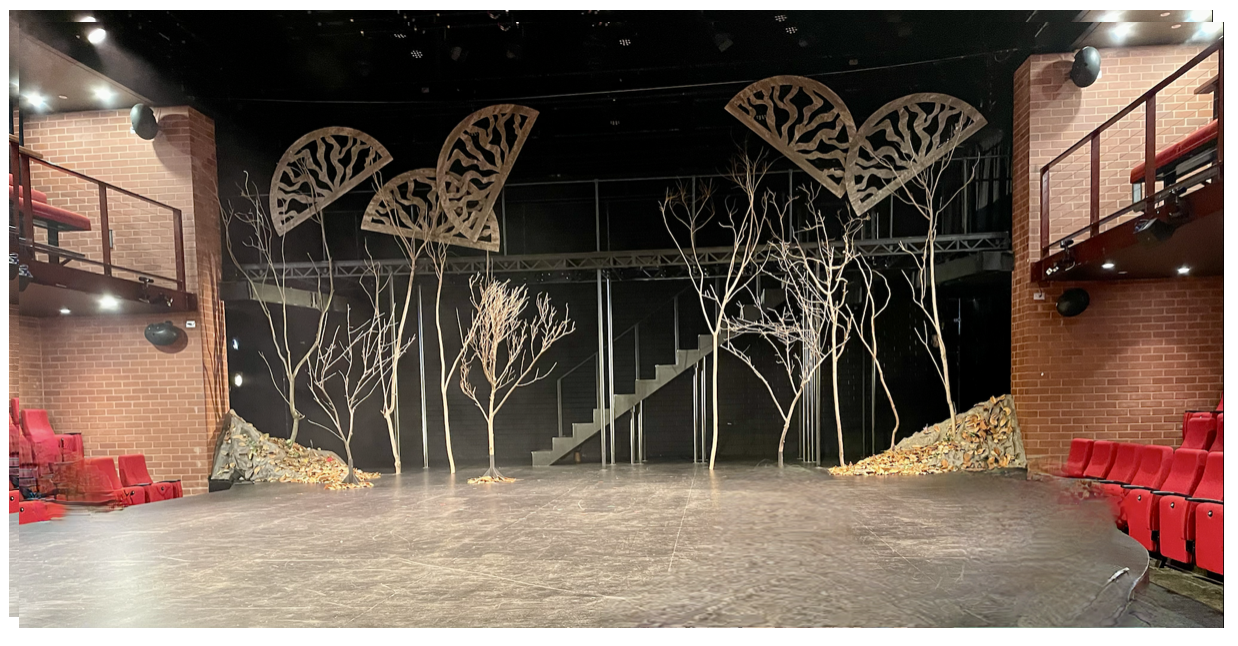…into WAAPA for production of Human Cannon by Edward Bond.
We are in the Enright Studio at WAAPA for the production of Edward Bond’s Human Cannon by Second Year actors.
The twelve scenes provide a sweeping portrait of social oppression, struggle during the years of the Spanish Civil War. Our focus is Agustina, mother, wife, revolutionary, symbol. At the play’s opening she is burying her dead new born unbaptised child in the face of the implacable power of Church. At the play’s closing, as she is about to face a firing squad, as she is shown the face of her daughter’s new born, she finds comfort and can smile. In between, bloody events of revolutionary savagery, acts of war, terrorism and betrayal on a foundation of love and loyalty. She becomes the human cannon aimed at the heart of inhuman cruelty.
The audience flank the acting space on two sides. We entered through a scatter of hard backed chairs, a door frame, a wooden table and minimal props; suspended from the ceiling are broken chairs. Light haze filters the lighting. Atmospheric music underscores the action.
The cast plays more than sixty roles. Sometimes generic revolutionaries or soldiers or cardboard cutout caricatures of power – Priest, Franco look alike, Vendors – sometimes named roles. The use of minimal props is noteworthy for students of drama – sticks and lumps of wood pressed into action as rifles and guns; a piece of fabric is pummelled as kneaded bread; wagon wheels and wood are shaped into a cannon. The use of sound effects was interesting – the loading and re-loading of the cannon – over the mimed actions using improvised props. The manipulation of minimal props and the easy transitions of locations was deftly handled (though I did feel that the weaving of chairs overhead was now a tired and overused theatrical commonplace – institutionalised to the point of overuse in Billy Elliot for example).
Edward Bond continues to have a throat-hold on theatrical power. The many inheritances of Brecht are evident. Announcing the titles of each section in handwritten chalk scrawled by the actors (but spell the title of the play correctly, please); the explicit telling of the fable of the play in the opening scene; the use of shadow puppetry; each scene presenting polemic dialectical discussion of themes embodied in human interactions. The push-pull of distancing us from the horror while also engaging us with gut-level action, worked. The broader socio-political purpose is foremost: the events from the Spanish Civil War serve as a template for wider struggles. This is a primer in recognising the broad purpose of theatre.
The production moves rapidly from scene to scene even though the sweep of words and dialogue is ever present. Not a short production (we have become so used to bite size theatre that maybe we have lost the stamina required!). There is richly evoked poetry. Agustina’s lament for her country – the long lyrical heart of the play – is powerfully evoked. It finishes with the ironical question: who could not be happy in such a land?
According to a 1987 source (Debusscher), Human Cannon is unproduced. It makes me wonder if this production is a first. It presents an interesting challenge if it is. As a vehicle for acting students, there is plenty of challenge and scope. I was uncomfortable with the accent work, which sometimes verged on cartoon or parody. But, overall, the production proved to be a a successfully managed challenge. And, sometimes, the well-intentioned movement work and Spanish clapping, was under-developed.
The fable of the piece is powerfully captured in the story of the stone and the tree. Again, Bond’s nimble and practised handling of his craft shows the strength of his writing as it was realised in this production.
Overall, a strong production with an interesting (and diverse) group of actors.
There is an excellent discussion of the play’s themes and contexts in Debusscher, G. (1987).










